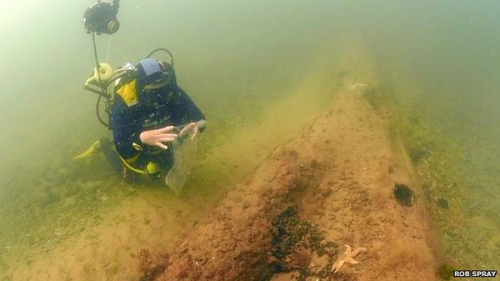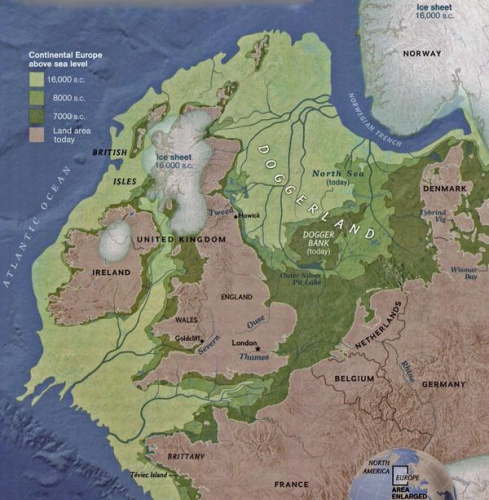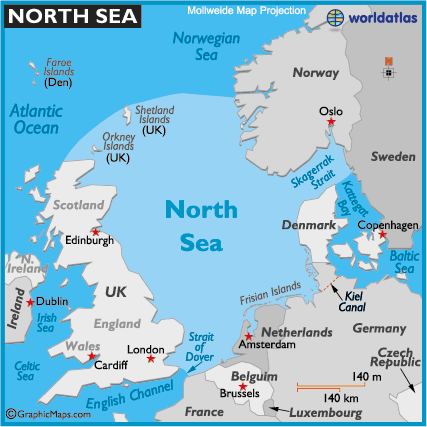Une plongeuse scientifique vient de découvrir les vestiges de l'immense forêt engloutie voici 6 000 ans entre France et Angleterre. Une jolie promenade dans le temps.
Pas de ferry. Encore moins de tunnel sous la Manche. Pensez : pas de Manche du tout...
Voici 10 000 ans, le niveau de la mer était plus bas qu’aujourd’hui. Au moins 100 mètres plus bas.
Les hommes du Mésolithique pouvaient donc traverser à pied sec ce qui deviendra le Channel. Et installer des campements sur les sommets qui s’élevaient de la plaine entre Bretagne et Normandie, et qui deviendront Jersey, Guernesey, Sercq, Aurigny et Chausey.
Un cercle de pierres vieux de 5 000 ans
Chausey, où un cercle de pierres mégalithique a été découvert dans la vase voici quelques années, vieux d’environ 5 000 ans – et à l’époque évidemment réalisé sur ce qui était alors de la terre ferme.

Voici 10 000 ans, en tout cas, une immense forêt couvrait la cuvette formée par la Manche, au fond de laquelle coulait un grand fleuve – la future Tamise.
Cette forêt, une plongeuse scientifique vient d’en découvrir des traces irréfutables.

Troncs d'arbres et branches recouverts d'algues
A l'occasion d'une plongée, Dawn Watson, océanographe a fait une découverte surprenante, rapportée par le Washington Post : les vestiges de cette forêt, engloutie voici environ 6 000 ans.
« J'ai d'abord pensé que c'était des morceaux d'épaves », a expliqué Dawn Watson à la BBC. Avant qu'elle se rende compte qu'il s'agissait de troncs d'arbres et de branches recouverts d'algues.
Les géologues connaissent cette forêt qui, à une période de glaciation (donc de bas niveau des océans), se dressait entre la France et l'Angleterre sur une terre appelée Doggerland (voir l'illustration ci-dessous).

Un vrai « paradis »
« Il y a 10 000 ans, cet espace était un des plus riches en matière de chasse, de capture d'oiseaux et de pêche en Europe », raconte Bernhard Weninger de l'université de Cologne. On y trouvait « un bassin important d'eau de source, alimenté par la Tamise à l'ouest et par le Rhin à l'est », explique le scientifique, qui n’hésite pas à comparer l’endroit à un « paradis ».
Cette forêt a été peu à peu engloutie lors de la dernière fonte des glaces, il y a environ 6 000 ans. Qui a aussi submergé ce qui deviendra la baie du Mont-Saint-Michel, isolant les îles Anglo-Normandes et Chausey.
Mais au fait, pourquoi ces traces n'ont-elles été trouvées qu'aujourd'hui ? L'océanographe Dawn Watson pense que si les vestiges de la forêt sont désormais visibles, c'est grâce à une tempête qui a touché la côte du comté de Norfolk en 2013. Et qui permet, aujourd'hui, de se promener dans les bois.
Hervé Hillard
Ancient underwater forest discovered off Norfolk coast
Nature experts have discovered a remarkable submerged forest thousands of years old under the sea close to the Norfolk coast.
The trees were part of an area known as 'Doggerland' which formed part of a much bigger area before it was flooded by the North Sea.
It was once so vast that hunter-gatherers who lived in the vicinity could have walked to Germany across its land mass.
The underwater forest was discovered by Dawn Watson and Rob Spray from Sea Search on a diving trip to study marine life.
The prehistoric forest lay undiscovered until it was exposed by the extreme storms along the east of England coast in December 2013.
BBC Inside Out's David Whiteley reveals exclusive underwater footage of the submerged forest which experts believe could date back more than 10,000 years.
Diver finds 10,000 year old FOREST stretched as far as Europe hidden under the North Sea
Diver finds 10,000-year-old FOREST which originally stretched as far as Europe hidden under the North Sea Diver Dawn Watson found incredible ancient forest under the North Sea The 45-year-old discovered oak trees with eight-metre branches off Norfolk 10,000-year-old trees appear to have been hidden underwater since Ice Age Experts believe pre-historic forest uncovered during recent stormy weather Ms Watson said she was 'absolutely thrilled' with find off Cley next the Sea
A shocked diver has found an incredible 10,000-year-old pre-historic forest under the North Sea and experts believe it could have once stretched as far as Europe.
Diver Dawn Watson, 45, discovered the remarkable 'lost forest' when she was diving just 300 metres off the coast of Cley next the Sea, Norfolk.
She found complete oak trees with branches measuring eight metres long under the sea and experts believe they have been hidden off the coast of Norfolk since the Ice Age.
The forest is believed to have become exposed following the stormy weather last winter.
Ms Watson, who runs the Marine Conservation Society's survey project, Seasearch in East Anglia with partner Rob Spray, said she was 'absolutely thrilled' with the find.
She said: 'I couldn't believe what I was seeing at first.
'The sea was quite rough by the shore so I decided to dive slightly further out and after swimming over 300 metres of sand I found a long blackened ridge.
'When I looked more closely I realised it was wood and when I swam further along I started finding whole tree trunks with branches on top, which looked like they had been felled.
'It was amazing to find and to think the trees had been lying there completely undiscovered for thousands of years. You certainly don't expect to go out for a quick dive and find a forest.'
Ms Watson, who has been diving in the North Sea for about 16 years, said the trees are thought to have formed part of a huge forest, measuring thousands of acres.
But it is believed the forest was drowned when the ice caps melted and the sea level rose 120 metres.
The fallen trees are now lying on the ground where they have formed a natural reef, which is teaming with colourful fish, plants and wildlife.
I created this video with the YouTube Slideshow Creator (http://www.youtube.com/upload)





 del.icio.us
del.icio.us
 Digg
Digg
Les commentaires sont fermés.